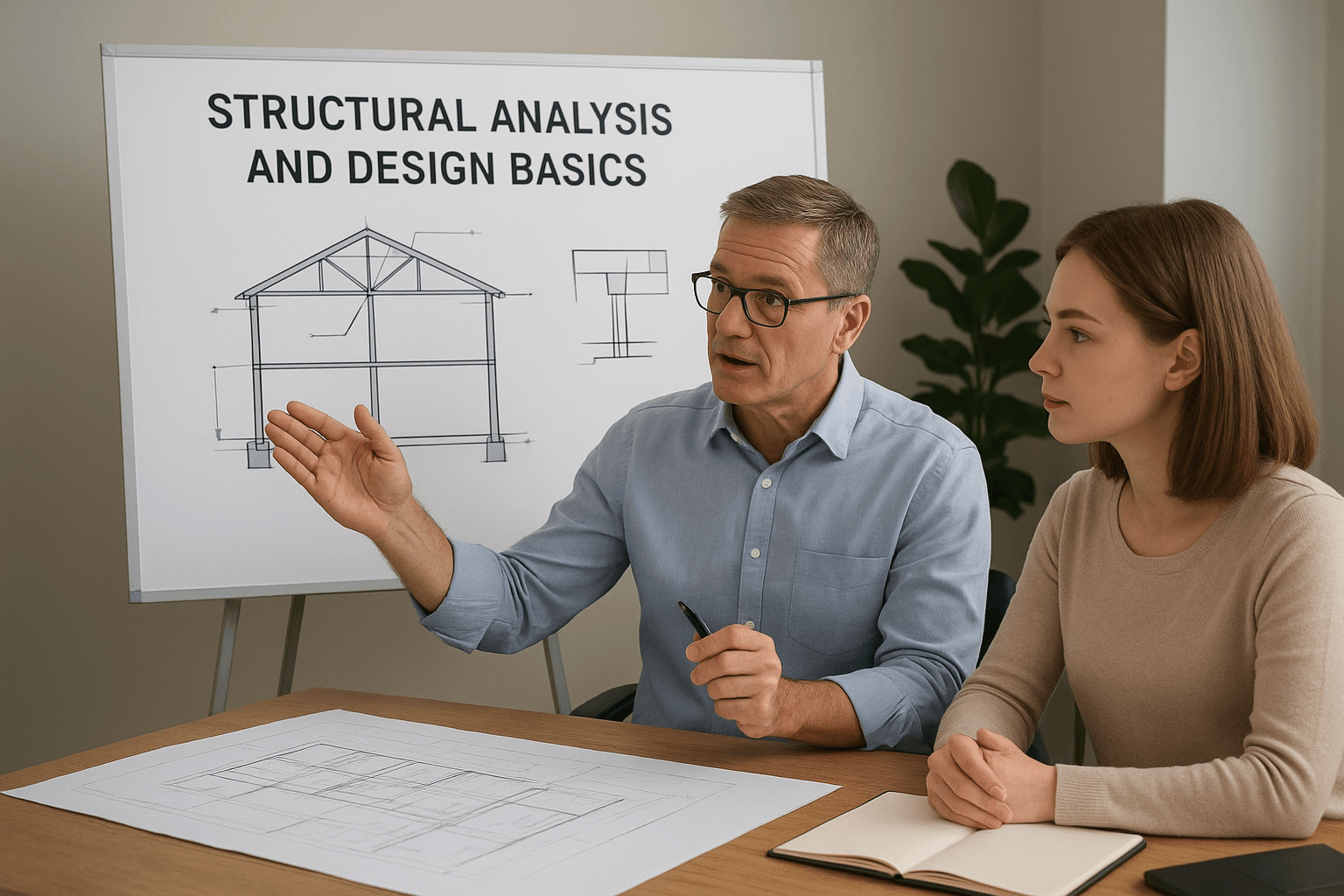Why Structural Knowledge Matters for Homeowners
Whether you’re planning a new home, renovating an old property, or investing in real estate, understanding the basics of structural engineering is crucial. While architects focus on how your building looks, structural engineers ensure that it stands strong and safe for decades.
For property owners, having a grasp of structural analysis basics and structural design fundamentals helps you make informed decisions, avoid costly mistakes, and communicate better with your construction team.
What is Structural Analysis and Design? (In Simple Terms)
Structural analysis and design is the process of determining how a structure will react to loads, forces, and environmental factors such as wind, earthquakes, and temperature changes.
Structural design involves creating a plan that ensures the building can handle these loads safely.
Think of structural analysis as testing the strength of your building and structural design as building it to be strong enough.
Why Every Property Owner Should Understand Structural Analysis
Knowing what every property owner should know about structural analysis can save you from expensive repairs and safety hazards. Here’s why:
- Safety — Prevents structural failure due to incorrect load assumptions.
- Cost Efficiency — Optimizes material use without compromising strength.
- Longevity — Ensures your building remains stable for decades.
- Legal Compliance — Meets building codes and safety regulations.
- Better Communication — Helps you understand engineer recommendations.
Key Principles of Structural Design Every Homeowner Should Understand
Here are structural design principles every homeowner should understand, especially in residential buildings:
| Principle | What It Means | Why It Matters |
| Load-Bearing Design | Walls, beams, or columns that carry the building’s weight and distribute it to the foundation. | Prevents overloading and collapse. |
| Load Types | Dead loads (permanent), live loads (temporary), environmental loads (wind, snow, earthquake). | Helps in accurate structural analysis. |
| Material Strength | Understanding concrete, steel, wood, and brick capabilities. | Ensures the right material for each part of the building. |
| Factor of Safety | Extra strength included beyond the expected load capacity. | Protects against unexpected stress or disasters. |
| Foundation Integrity | The base that supports the entire structure. | A weak foundation means a weak building. |
Structural Analysis Basics for Residential Buildings
When applying structural analysis basics to your home, engineers look at:
- Loads — Calculating all forces acting on the structure.
- Stress and Strain — Measuring material deformation under load.
- Structural Stability — Ensuring the building won’t tip, bend, or buckle.
- Deflection Limits — Controlling bending to maintain safety and comfort.
- Seismic & Wind Considerations — Especially in earthquake- or storm-prone areas.
Read also: The Latest Trends in Interior Design: Insights from Siliguri
Load-Bearing Design Explained for Property Owners
Load-bearing design is one of the most important structural design fundamentals.
Types of Load-Bearing Elements in Homes:
- Walls — Transfer loads vertically to the foundation.
- Beams — Distribute loads horizontally between supports.
- Columns — Vertical members that carry loads from beams or slabs.
- Slabs — Horizontal plates forming floors and ceilings.
Tip for Homeowners: Never remove or alter a load-bearing wall without professional approval. It could compromise the entire structure.
Common Structural Engineering Tips for Homeowners
- Hire a Licensed Structural Engineer — They ensure compliance with building codes.
- Don’t Overload Floors — Especially with heavy furniture or water tanks.
- Inspect After Extreme Weather — Check for cracks, tilts, or foundation settlement.
- Plan for Future Modifications — Structural provisions make renovations easier later.
- Prioritize Quality Materials — Cheap materials may save money now but cost more in repairs.
Read also: How 3D Elevation & Interior Visualization Can Save You Money
Guide to Structural Analysis and Design for Property Owners
Here’s a quick homeowner-friendly process for understanding and managing structural design:
- Initial Consultation — Meet with an architect and structural engineer.
- Preliminary Analysis — Assess site conditions, soil type, and climate factors.
- Load Calculations — Engineer determines expected forces.
- Material Selection — Choose materials based on strength, durability, and budget.
- Design Finalization — Engineer creates drawings with precise specifications.
- Construction Monitoring — Ensure execution matches the approved design.
- Post-Construction Inspection — Verify safety before moving in.
- Conclusion — Build With Confidence, Live With Peace of Mind
- Understanding how to understand structural analysis as a homeowner is not about becoming an engineer — it’s about being an informed decision-maker. By learning the structural design basics for residential buildings, you ensure safety, durability, and long-term value.
- A safe home isn’t just beautiful — it’s structurally sound.
✅ Ready to Plan Your Home’s Structure the Right Way?
We specialize in structural design for property owners, from load-bearing design explained for property owners to full structural analysis basics tailored for your site.
📞 Call Us Today: +91-82500 86323, +91-90462 50581
🌐 Visit: ebcsiliguri.com
📍 Based in Siliguri | Serving India
FAQs — Structural Design and Analysis for Homeowners
Q1: Is structural design only for large buildings?
No. Structural design basics for residential buildings are just as important as for high-rises.
Q2: How can a homeowner understand structural analysis without technical knowledge?
By learning key terms, asking your engineer to explain in plain language, and using simple diagrams.
Q3: Why does structural design matter for property safety?
Because it prevents collapse, ensures stability during disasters, and prolongs the building’s lifespan.
Read also: Accurate Building Estimate – Avoiding Budget Surprises




Comments are closed